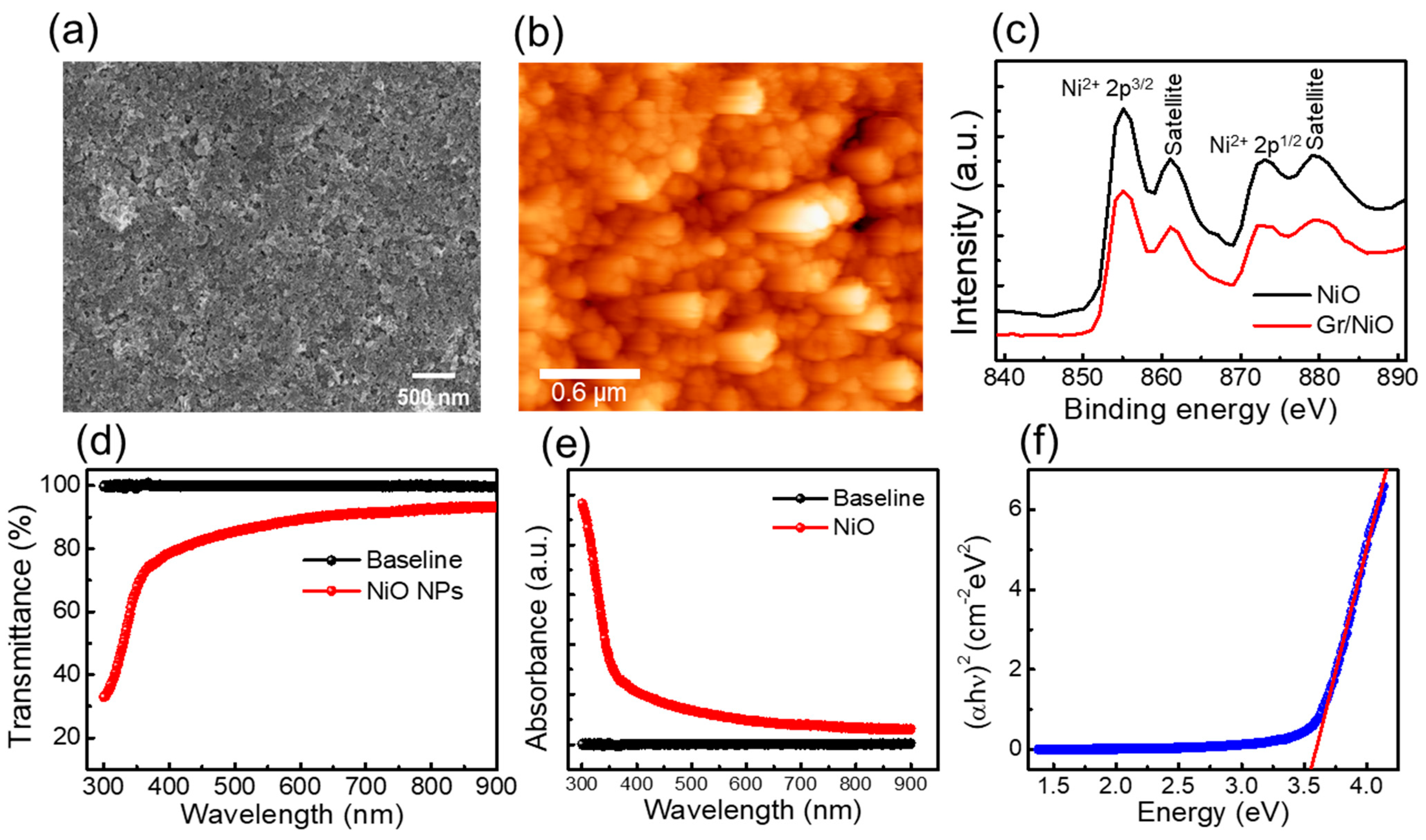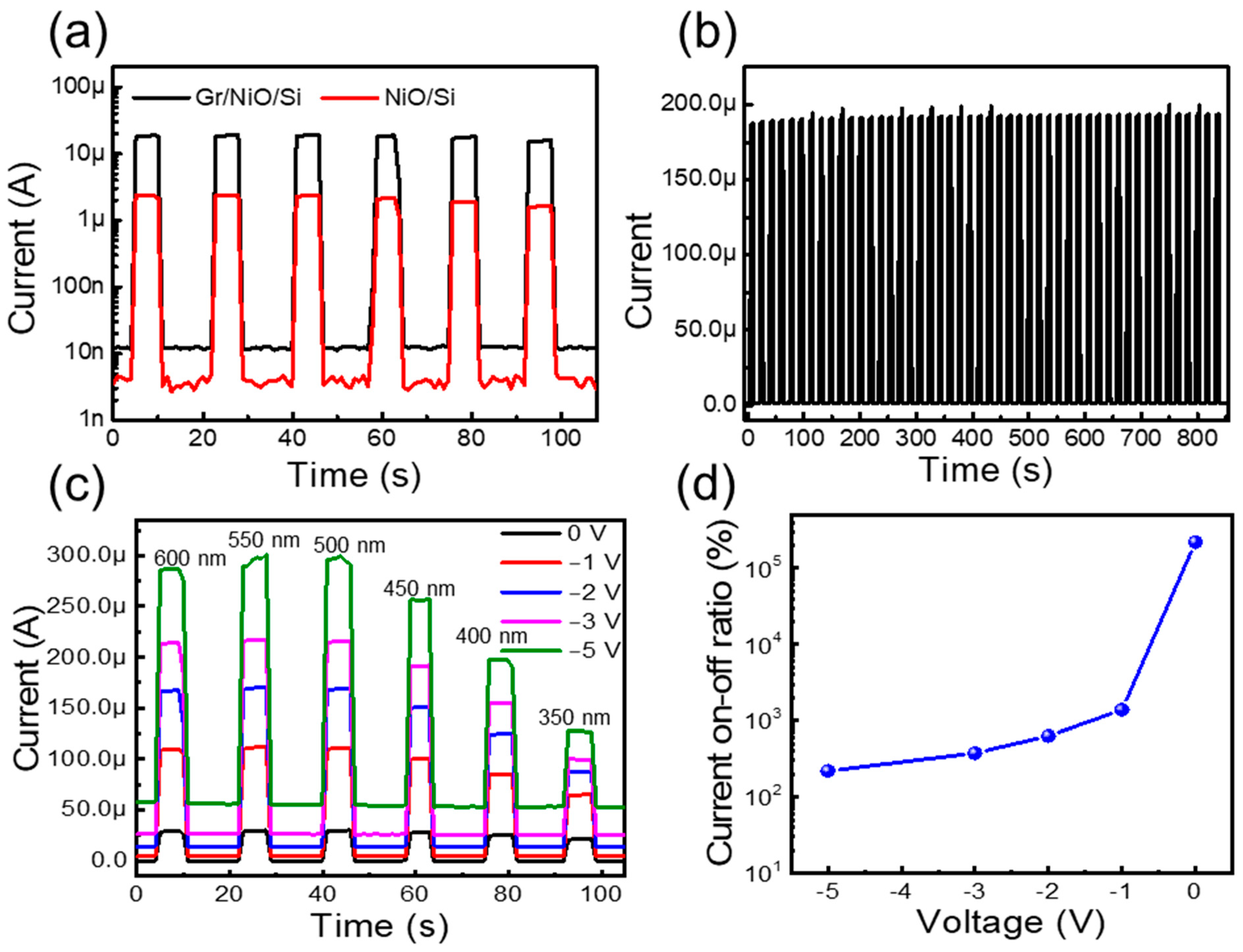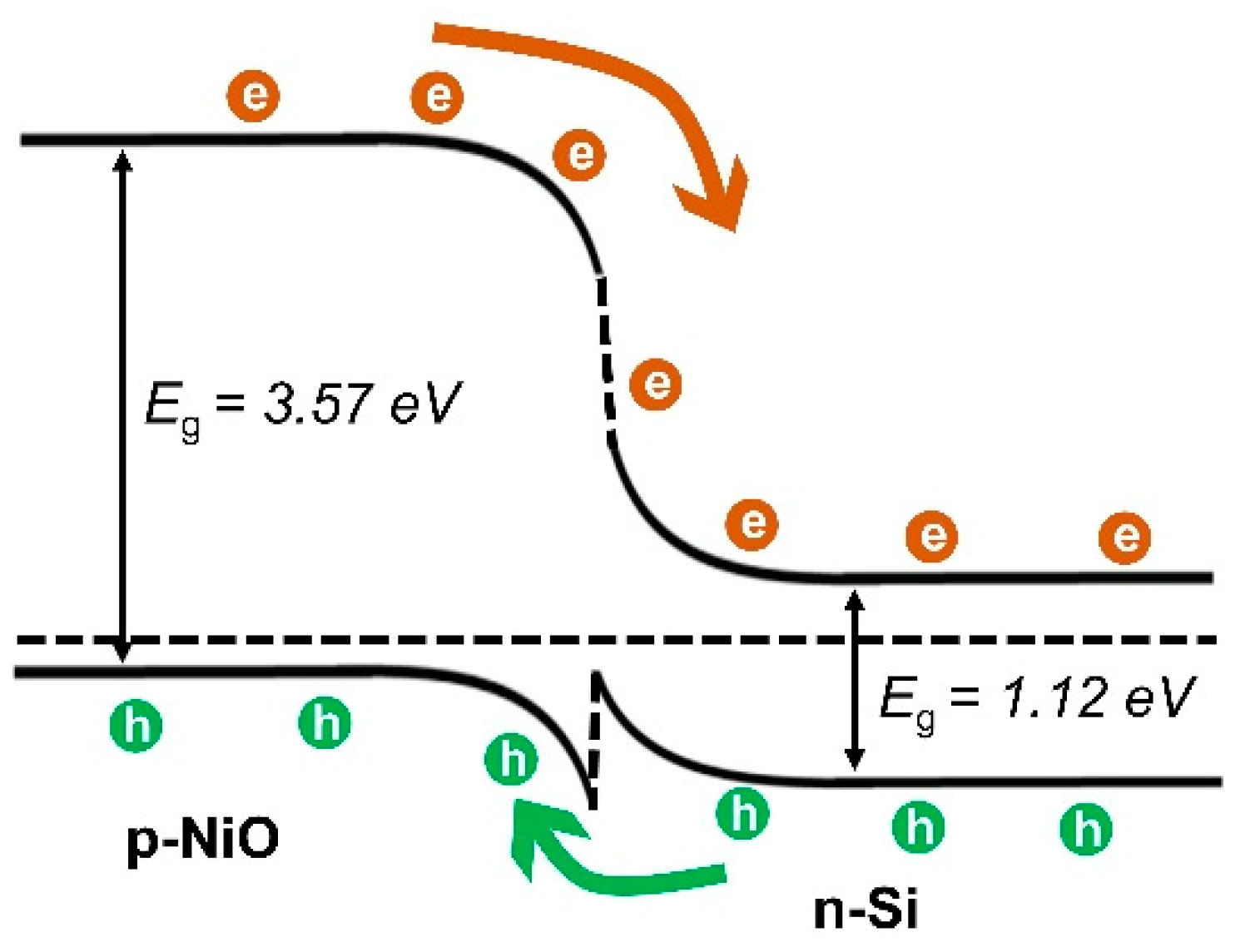Self-Powered Broadband Photodetector Based on NiO/Si Heterojunction Incorporating Graphene Transparent Conducting Layer
Abstract
:1. Introduction
2. Experiment
3. Results and Discussion
4. Conclusions
Author Contributions
Funding
Data Availability Statement
Conflicts of Interest
References
- García de Arquer, F.P.; Armin, A.; Meredith, P.; Sargent, E.H. Solution-processed semiconductors for next-generation photodetectors. Nat. Rev. Mater. 2017, 2, 16100. [Google Scholar] [CrossRef]
- Chen, H.; Liu, K.; Hu, L.; Al-Ghamdi, A.A.; Fang, X. New concept ultraviolet photodetectors. Mater. Today 2015, 18, 493–502. [Google Scholar] [CrossRef]
- Monroy, E.; Omnès, F.; Calle, F. Wide-bandgap semiconductor ultraviolet photodetectors. Semicond. Sci. Technol. 2003, 18, R33. [Google Scholar] [CrossRef]
- Long, M.; Wang, P.; Fang, H.; Hu, W. Progress, challenges, and opportunities for 2D material based photodetectors. Adv. Funct. Mater. 2019, 29, 1803807. [Google Scholar] [CrossRef]
- Zou, Y.; Zhang, Y.; Hu, Y.; Gu, H. Ultraviolet detectors based on wide bandgap semiconductor nanowire: A review. Sensors 2018, 18, 2072. [Google Scholar] [CrossRef]
- Razeghi, M.; Rogalski, A. Semiconductor ultraviolet detectors. J. Appl. Phys. 1996, 79, 7433–7473. [Google Scholar] [CrossRef]
- Xie, C.; Lu, X.T.; Tong, X.W.; Zhang, Z.X.; Liang, F.X.; Liang, L.; Luo, L.B.; Wu, Y.C. Recent progress in solar-blind deep-ultraviolet photodetectors based on inorganic ultrawide bandgap semiconductors. Adv. Funct. Mater. 2019, 29, 1806006. [Google Scholar] [CrossRef]
- Sang, L.; Liao, M.; Sumiya, M. A comprehensive review of semiconductor ultraviolet photodetectors: From thin film to one-dimensional nanostructures. Sensors 2013, 13, 10482–10518. [Google Scholar] [CrossRef]
- Pandit, B.; Schubert, E.F.; Cho, J. Dual-functional ultraviolet photodetector with graphene electrodes on AlGaN/GaN heterostructure. Sci. Rep. 2020, 10, 22059. [Google Scholar] [CrossRef]
- Pandit, B.; Jang, H.S.; Jeong, Y.; An, S.; Chandramohan, S.; Min, K.K.; Won, S.M.; Choi, C.J.; Cho, J.; Hong, S. Highly Sensitive Ultraviolet Photodetector Based on an AlGaN/GaN HEMT with Graphene-On-p-GaN Mesa Structure. Adv. Mater. Interfaces 2023, 10, 2202379. [Google Scholar] [CrossRef]
- Tsao, J.; Chowdhury, S.; Hollis, M.; Jena, D.; Johnson, N.; Jones, K.; Kaplar, R.; Rajan, S.; Van de Walle, C.; Bellotti, E. Ultrawide-bandgap semiconductors: Research opportunities and challenges. Adv. Electron. Mater. 2018, 4, 1600501. [Google Scholar] [CrossRef]
- Chen, J.; Ouyang, W.; Yang, W.; He, J.H.; Fang, X. Recent progress of heterojunction ultraviolet photodetectors: Materials, integrations, and applications. Adv. Funct. Mater. 2020, 30, 1909909. [Google Scholar] [CrossRef]
- Lany, S. Semiconducting transition metal oxides. J. Phys. Condens. Matter 2015, 27, 283203. [Google Scholar] [CrossRef]
- dos Santos, R.B.; Rivelino, R.; Gueorguiev, G.K.; Kakanakova-Georgieva, A. Exploring 2D structures of indium oxide of different stoichiometry. CrystEngComm 2021, 23, 6661–6667. [Google Scholar] [CrossRef]
- Kakanakova-Georgieva, A.; Giannazzo, F.; Nicotra, G.; Cora, I.; Gueorguiev, G.K.; Persson, P.O.; Pécz, B. Material proposal for 2D indium oxide. Appl. Surf. Sci. 2021, 548, 149275. [Google Scholar] [CrossRef]
- Kim, S.; Lim, H.; Kim, S.; Pandit, B.; Cho, J.; Kang, H.C. Synthesis of SnO2 nanowires using thermal chemical vapor deposition with SnO powder and their application as self-powered ultraviolet photodetectors. J. Alloys Compd. 2023, 963, 171265. [Google Scholar] [CrossRef]
- Shin, H.; Luo, Y.; Ganesh, P.; Balachandran, J.; Krogel, J.T.; Kent, P.R.; Benali, A.; Heinonen, O. Electronic properties of doped and defective NiO: A quantum Monte Carlo study. Phys. Rev. Mater. 2017, 1, 073603. [Google Scholar] [CrossRef]
- Shi, J.; Zhang, J.; Yang, L.; Qu, M.; Qi, D.C.; Zhang, K.H. Wide bandgap oxide semiconductors: From materials physics to optoelectronic devices. Adv. Mater. 2021, 33, 2006230. [Google Scholar] [CrossRef]
- Chai, H.; Zheng, Z.; Liu, K.; Xu, J.; Wu, K.; Luo, Y.; Liao, H.; Debliquy, M.; Zhang, C. Stability of metal oxide semiconductor gas sensors: A review. IEEE Sens. J. 2022, 22, 5470–5481. [Google Scholar] [CrossRef]
- Desissa, T.D. NiO–ZnO based junction interface as high-temperature contact materials. Ceram. Int. 2021, 47, 8053–8059. [Google Scholar] [CrossRef]
- Jlassi, M.; Sta, I.; Hajji, M.; Ezzaouia, H. Synthesis and characterization of nickel oxide thin films deposited on glass substrates using spray pyrolysis. Appl. Surf. Sci. 2014, 308, 199–205. [Google Scholar] [CrossRef]
- Jarze̦bski, Z.M. Oxide Semiconductors; Pergamon Press: Oxford, UK, 1973. [Google Scholar]
- Forin, C.C.; Purica, M.; Budianu, E.; Schiopu, P. p-NiO/ITO transparent heterojunction—Preparation and characterization. In Proceedings of the CAS 2012 (International Semiconductor Conference), Sinaia, Romania, 15–17 October 2012; IEEE: New York, NY, USA, 2012; pp. 131–134. [Google Scholar]
- Zhang, D.; Nozaki, S.; Uchida, K. NiO/Si heterostructures formed by UV oxidation of nickel deposited on Si substrates. J. Vac. Sci. Technol. B 2014, 32, 031202. [Google Scholar] [CrossRef]
- Hsu, F.H.; Wang, N.F.; Tsai, Y.Z.; Cheng, Y.S.; Houng, M.P. A new p-Ni1–xO: Li/n-Si heterojunction solar cell fabricated by RF magnetron sputtering. J. Phys. D Appl. Phys. 2013, 46, 275104. [Google Scholar] [CrossRef]
- Irwin, M.D.; Servaites, J.D.; Buchholz, D.B.; Leever, B.J.; Liu, J.; Emery, J.D.; Zhang, M.; Song, J.-H.; Durstock, M.F.; Freeman, A.J. Structural and electrical functionality of NiO interfacial films in bulk heterojunction organic solar cells. Chem. Mater. 2011, 23, 2218–2226. [Google Scholar] [CrossRef]
- Parida, B.; Kim, S.; Oh, M.; Jung, S.; Baek, M.; Ryou, J.-H.; Kim, H. Nanostructured-NiO/Si heterojunction photodetector. Mater. Sci. Semicond. Process. 2017, 71, 29–34. [Google Scholar] [CrossRef]
- Zhang, Y.; Ji, T.; Zhang, W.; Guan, G.; Ren, Q.; Xu, K.; Huang, X.; Zou, R.; Hu, J. A self-powered broadband photodetector based on an n-Si(111)/p-NiO heterojunction with high photosensitivity and enhanced external quantum efficiency. J. Mater. Chem. C 2017, 5, 12520–12528. [Google Scholar] [CrossRef]
- Kuru, C.; Yavuz, S.; Kargar, A.; Choi, D.; Choi, C.; Rustomji, C.; Jin, S.; Bandaru, P.R. Enhanced power conversion efficiency of graphene/silicon heterojunction solar cells through NiO induced doping. J. Nanosci. Nanotechnol. 2016, 16, 1190–1193. [Google Scholar] [CrossRef]
- Yang, H.; Guai, G.H.; Guo, C.; Song, Q.; Jiang, S.P.; Wang, Y.; Zhang, W.; Li, C.M. NiO/graphene composite for enhanced charge separation and collection in p-type dye sensitized solar cell. J. Phys. Chem. C 2011, 115, 12209–12215. [Google Scholar] [CrossRef]
- Kim, J.H.; Liang, P.W.; Williams, S.T.; Cho, N.; Chueh, C.C.; Glaz, M.S.; Ginger, D.S.; Jen, A.K.Y. High-performance and environmentally stable planar heterojunction perovskite solar cells based on a solution-processed copper-doped nickel oxide hole-transporting layer. Adv. Mater. 2015, 27, 695–701. [Google Scholar] [CrossRef]
- Geim, A.K.; Novoselov, K.S. The rise of graphene. Nat. Mater. 2007, 6, 183–191. [Google Scholar] [CrossRef]
- Bonaccorso, F.; Sun, Z.; Hasan, T.; Ferrari, A. Graphene photonics and optoelectronics. Nat. Photonics 2010, 4, 611–622. [Google Scholar] [CrossRef]
- Li, W.; Liu, M.; Cheng, S.; Zhang, H.; Yang, W.; Yi, Z.; Zeng, Q.; Tang, B.; Ahmad, S.; Sun, T. Polarization independent tunable bandwidth absorber based on single-layer graphene. Diam. Relat. Mater. 2024, 142, 110793. [Google Scholar] [CrossRef]
- Jiang, B.; Hou, Y.; Wu, J.; Ma, Y.; Gan, X.; Zhao, J. In-fiber photoelectric device based on graphene-coated tilted fiber grating. Opto-Electron. Sci. 2023, 2, 230012-1–230012-10. [Google Scholar] [CrossRef]
- Zeng, C.; Lu, H.; Mao, D.; Du, Y.; Hua, H.; Zhao, W.; Zhao, J. Graphene-empowered dynamic metasurfaces and metadevices. Opto-Electron. Adv. 2022, 5, 200098. [Google Scholar] [CrossRef]
- Lin, S.; Lu, Y.; Xu, J.; Feng, S.; Li, J. High performance graphene/semiconductor van der Waals heterostructure optoelectronic devices. Nano Energy 2017, 40, 122–148. [Google Scholar] [CrossRef]
- Dubey, P.; Kaurav, N.; Devan, R.S.; Okram, G.; Kuo, Y. The effect of stoichiometry on the structural, thermal and electronic properties of thermally decomposed nickel oxide. RSC Adv. 2018, 8, 5882–5890. [Google Scholar] [CrossRef]
- Ramkumar, R.; Dhakal, G.; Shim, J.-J.; Kim, W.K. NiO/Ni Nanowafer Aerogel Electrodes for High Performance Supercapacitors. Nanomaterials 2022, 12, 3813. [Google Scholar] [CrossRef]
- Chen, Y.; Kang, J.; Chen, B.; Gao, B.; Liu, L.; Liu, X.; Wang, Y.; Wu, L.; Yu, H.; Wang, J. Microscopic mechanism for unipolar resistive switching behaviour of nickel oxides. J. Phys. D Appl. Phys. 2012, 45, 065303. [Google Scholar] [CrossRef]
- El-Kemary, M.; Nagy, N.; El-Mehasseb, I. Nickel oxide nanoparticles: Synthesis and spectral studies of interactions with glucose. Mater. Sci. Semicond. Process. 2013, 16, 1747–1752. [Google Scholar] [CrossRef]
- Nishi, Y.; Iwata, T.; Kimoto, T. Correlation between oxygen composition and electrical properties in NiO thin films for resistive random access memory. Jpn. J. Appl. Phys. 2011, 50, 015802. [Google Scholar] [CrossRef]
- Puspharajah, P.; Radhakrishna, S.; Arof, A. Transparent conducting lithium-doped nickel oxide thin films by spray pyrolysis technique. J. Mater. Sci. 1997, 32, 3001–3006. [Google Scholar] [CrossRef]
- Jang, W.-L.; Lu, Y.-M.; Hwang, W.-S.; Chen, W.-C. Electrical properties of Li-doped NiO films. J. Eur. Ceram. Soc. 2010, 30, 503–508. [Google Scholar] [CrossRef]
- Choi, J.-M.; Im, S. Ultraviolet enhanced Si-photodetector using p-NiO films. Appl. Surf. Sci. 2005, 244, 435–438. [Google Scholar] [CrossRef]
- Pandit, B.; Cho, J. AlGaN Ultraviolet Metal–Semiconductor–Metal Photodetectors with Reduced Graphene Oxide Contacts. Appl. Sci. 2018, 8, 2098. [Google Scholar] [CrossRef]
- Pandit, B.; Cho, J. Solar-blind ultraviolet photodetectors with thermally reduced graphene oxide formed on high-Al-content AlGaN layers. AIP Adv. 2021, 11, 115322. [Google Scholar] [CrossRef]
- Khusayfan, N.M. Electrical and photoresponse properties of Al/graphene oxide doped NiO nanocomposite/p-Si/Al photodiodes. J. Alloys Compd. 2016, 666, 501–506. [Google Scholar] [CrossRef]
- Gupta, R.; Hendi, A.; Cavas, M.; Al-Ghamdi, A.A.; Al-Hartomy, O.A.; Aloraini, R.; El-Tantawy, F.; Yakuphanoglu, F. Improvement of photoresponse properties of NiO/p-Si photodiodes by copper dopant. Phys. E Low-Dimens. Syst. Nanostruct. 2014, 56, 288–295. [Google Scholar] [CrossRef]
- Chen, W.; Wu, Y.; Fan, J.; Djurišić, A.B.; Liu, F.; Tam, H.W.; Ng, A.; Surya, C.; Chan, W.K.; Wang, D. Perovskite Solar Cells: Understanding the Doping Effect on NiO: Toward High-Performance Inverted Perovskite Solar Cells. Adv. Energy Mater. 2018, 8, 1870091. [Google Scholar] [CrossRef]
- Li, G.; Liu, L.; Wu, G.; Chen, W.; Qin, S.; Wang, Y.; Zhang, T. Self-powered UV–near infrared photodetector based on reduced graphene oxide/n-Si vertical heterojunction. Small 2016, 12, 5019–5026. [Google Scholar] [CrossRef]
- Kim, H.-S.; Seo, J.-Y.; Xie, H.; Lira-Cantu, M.; Zakeeruddin, S.M.; Gratzel, M.; Hagfeldt, A. Effect of Cs-incorporated NiOx on the performance of perovskite solar cells. ACS Omega 2017, 2, 9074–9079. [Google Scholar] [CrossRef]
- Hadi, A.A.; Badr, B.A.; Mahdi, R.O.; Khashan, K.S. Rapid laser fabrication of Nickel oxide nanoparticles for UV detector. Optik 2020, 219, 165019. [Google Scholar] [CrossRef]
- Ahmed, A.A.; Hashim, M.; Abdalrheem, R.; Rashid, M. High-performance multicolor metal-semiconductor-metal Si photodetector enhanced by nanostructured NiO thin film. J. Alloys Compd. 2019, 798, 300–310. [Google Scholar] [CrossRef]
- Ahmed, A.A.; Devarajan, M.; Afzal, N. Fabrication and characterization of high performance MSM UV photodetector based on NiO film. Sens. Actuators A Phys. 2017, 262, 78–86. [Google Scholar] [CrossRef]
- Zhang, Y.; Ji, T.; Zou, R.; Ha, E.; Hu, X.; Cui, Z.; Xu, C.; Xu, K.; Zhang, Y.; Hu, J. An efficiently enhanced UV-visible light photodetector with a Zn: NiO/p-Si isotype heterojunction. J. Mater. Chem. C 2020, 8, 3498–3508. [Google Scholar] [CrossRef]
- Ahmed, A.A.; Hashim, M.; Qahtan, T.F.; Rashid, M. Preparation and characteristics study of self-powered and fast response p-NiO/n-Si heterojunction photodetector. Ceram. Int. 2022, 48, 20078–20089. [Google Scholar] [CrossRef]
- Salih, E.Y.; Bashir, M.B.A.; Rajpar, A.H.; Badruddin, I.A.; Bahmanrokh, G. Rapid fabrication of NiO/porous Si film for ultra-violate photodetector: The effect of laser energy. Microelectron. Eng. 2022, 258, 111758. [Google Scholar] [CrossRef]
- Castillo-Saenz, J.; Nedev, N.; Valdez-Salas, B.; Bernechea, M.; Martínez-Guerra, E.; Mendivil-Palma, I.; Curiel-Alvarez, M.; Mateos, D.; Perez-Landeros, O. Effect of oxidation temperature on the properties of NiOx layers for application in optical sensors. Thin Solid Film. 2021, 734, 138849. [Google Scholar] [CrossRef]
- Reddy, K.C.S.; Sahatiya, P.; Santos-Sauceda, I.; Cortázar, O.; Ramírez-Bon, R. One-step fabrication of 1D p-NiO nanowire/n-Si heterojunction: Development of self-powered ultraviolet photodetector. Appl. Surf. Sci. 2020, 513, 145804. [Google Scholar] [CrossRef]
- Al-Hardan, N.H.; Ahmed, N.M.; Almessiere, M.A.; Aziz, A.A. Low-intensity UV light sensor based on p-NiO/n-Si heterojunction. Mater. Res. Express 2020, 6, 126332. [Google Scholar] [CrossRef]






| PD | Responsivity (A/W) | Dark Current (A) | Wavelength (nm) | Photocurrent | Trise (s) | Tfall (s) | Detectivity (cmHz1/2W−1) | Bias (V) | Ref. |
|---|---|---|---|---|---|---|---|---|---|
| Al/NiO/Si/Al | 0.7 | NA | 330 | NA | NA | NA | 63 × 1012 | −3 | [53] |
| NiO/n-Si | ~0.15@0 V ~0.17@30 V | NA | 290 | NA | NA | NA | NA | 0 | [45] |
| Ni/NiO/p-Si/InGa | 0.156 1 V | 3.9 × 10−8 | 385 | 7.1 × 10−7 | 0.5 | NA | NA | −3 | [27] |
| Au/NiO/Si MSM | ~6.5 | 2.32 μA | 365 | NA | 0.11 | NA | NA | 5 | [54] |
| Au/NiO/Si MSM | 4.5 | ~5 μA | 365 | NA | 226 ms | 200 ms | NA | 5 | [55] |
| Ag/Zn:NiO/p-Si/Ag | 0.249 | ~13 μA cm−2 (−1 V) | 350 | 79 μA cm−2 | 0.3 | NA | 2.3 × 1011 (−1 V) | −4 | [56] |
| Ag/NiO/n-Si/Ag | 0.43 | 7 μA cm−2 (−0.2 V) | 600 | 2.5 × 105 | 30 ms | NA | 1.5 × 1010 (0 V) | −2 | [28] |
| NiO/n-Si | 0.013 | 3.9 × 10−9 | 365 | NA | 85 ms | 85 ms | 1.03 × 1011 | 0 | [57] |
| Al/NiO/Si MSM | 91 μA/mW | 59 μA | 350 | NA | 750 ms | 800 ms | NA | 0.2 | [58] |
| NiO/n-Si PD | 0.83 | 9.1 × 10−12 | 365 | 2.8 × 10−8 | 0.1 | 0.1 | NA | 0 | [59] |
| NiO NW/n-Si(100) | 9.1 mA W−1 | NA | 350 | NA | 0.4 | NA | 1.8 × 109 | 0 | [60] |
| NiO/n-Si | 160 mA W−1 | NA | 365 | NA | 1.5 | NA | NA | 5 | [61] |
| graphene/NiO/n-Si | 0.055 | 3.35 × 10−9 | 350 | 2.9 × 10−5 | <0.8 | <0.8 | 1.66 × 1012 | 0 | This work |
| 0.15 | 1.82 × 10−6 | 7.3 × 10−5 | 1.78 × 1011 | −5 |
Disclaimer/Publisher’s Note: The statements, opinions and data contained in all publications are solely those of the individual author(s) and contributor(s) and not of MDPI and/or the editor(s). MDPI and/or the editor(s) disclaim responsibility for any injury to people or property resulting from any ideas, methods, instructions or products referred to in the content. |
© 2024 by the authors. Licensee MDPI, Basel, Switzerland. This article is an open access article distributed under the terms and conditions of the Creative Commons Attribution (CC BY) license (https://creativecommons.org/licenses/by/4.0/).
Share and Cite
Pandit, B.; Parida, B.; Jang, H.-S.; Heo, K. Self-Powered Broadband Photodetector Based on NiO/Si Heterojunction Incorporating Graphene Transparent Conducting Layer. Nanomaterials 2024, 14, 551. https://doi.org/10.3390/nano14060551
Pandit B, Parida B, Jang H-S, Heo K. Self-Powered Broadband Photodetector Based on NiO/Si Heterojunction Incorporating Graphene Transparent Conducting Layer. Nanomaterials. 2024; 14(6):551. https://doi.org/10.3390/nano14060551
Chicago/Turabian StylePandit, Bhishma, Bhaskar Parida, Hyeon-Sik Jang, and Keun Heo. 2024. "Self-Powered Broadband Photodetector Based on NiO/Si Heterojunction Incorporating Graphene Transparent Conducting Layer" Nanomaterials 14, no. 6: 551. https://doi.org/10.3390/nano14060551






